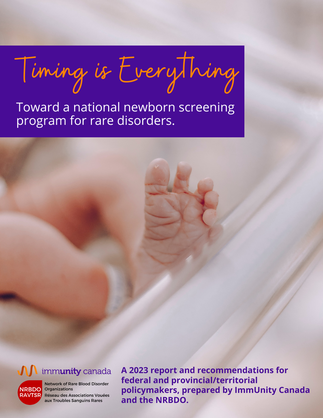It's time for a Canadian National Newborn Screening Program for Rare Diseases.
ImmUnity Canada and the Network for Rare Blood Disorder Organizations (NRBDO) have collaborated to create a report that centres the patient perspective and examines potential roles for the federal government in an equitable pan-Canadian approach to newborn screening for rare diseases.
ImmUnity Canada and the Network for Rare Blood Disorder Organizations (NRBDO) have collaborated to create a report that centres the patient perspective and examines potential roles for the federal government in an equitable pan-Canadian approach to newborn screening for rare diseases.
Get the Report
About Newborn Screening
- Considered to be one of the greatest public health achievements of our time.
- With just a small sample of blood drawn for a heel prick shortly after birth, we can screen for conditions that respond to early treatment and interventions, altering the course or severity of the condition to improve the child’s well-being.
Newborn Screening Across Canada
|
Why Newborn Screening?
400,000,000
people are living with
10,867
life-threatening rare diseases
92%
of rare diseases are suspected to have a genetic basis
5-7 years
is the average time to accurate diagnosis
“It is becoming apparent that so-called 'rare' inherited diseases are the most prevalent cause of mortality and morbidity in children. Indeed, it is estimated that 1 in 3 pediatric hospital beds in Canada is occupied by a child with an inherited disease."
- Dr. Christopher McMaster, CIHR
- Dr. Christopher McMaster, CIHR
Why now? Looking Ahead
|
Challenges & Opportunities
Recommendations
- Fund the CPHLN to act as the administrative support for a National Newborn Screening Advisory Committee, which would have a transparent mechanism for reviewing conditions and meet regularly to consider additions to the core list.
- Adopt an agreed-upon set of principles, such as Dobrow et al. which builds on the Wilson and Jungner principles of screening, to use when considering new additions to the national screening panel.
- Continue to allow for provinces to review conditions on a regional and demographic basis.
- Leverage the network of labs to work with the National Newborn Screening Advisory Committee to develop standard operating procedures and conduct specialized rare tests.
- Consider methods of improving and centralizing reporting to lead to an improved understanding of rare disease prevalence and a more accurate allocation of care, medicine, and research resources. This could include leveraging already existing frameworks, such as SPOR (Strategy for Patient Oriented Research, CIHR) and/or developing a registry to monitor follow up and long term care nationally.
- Request the National Newborn Screening Advisory Committee to also provide guidance and best practices for uniformity on the various ethical, communication, data management and sharing, legal, and social implications of newborn screening programs.
The Federal RoleAccording to the Health Canada report, Building a National Strategy for Drugs for Rare Diseases: What We Heard from Canadians, next steps include considering ‘how best to support patients more holistically, including diagnostics, screening and genetic testing.’
We believe that a national newborn screening program delivers on the drugs for rare diseases strategy, and that the offer from CPHLN to offer administrative support is an elegant and efficient solution that should be explored further for inclusion in the strategy. Through increased collaboration, knowledge exchange, and federal support, Canada's national newborn screening program could be robust and sustainable, and provide equitable access to all newborns across the country, regardless of where they are born. |





